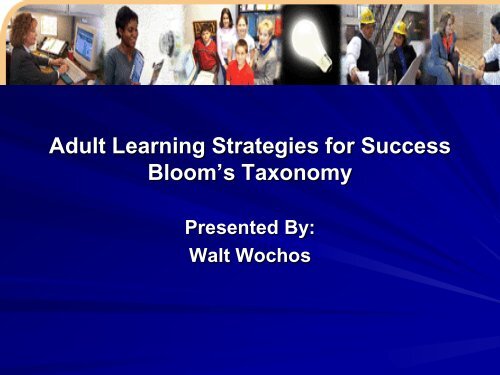Adult Learning Strategies for Success Bloom's Taxonomy - CAAHE.org
Adult Learning Strategies for Success Bloom's Taxonomy - CAAHE.org
Adult Learning Strategies for Success Bloom's Taxonomy - CAAHE.org
- No tags were found...
You also want an ePaper? Increase the reach of your titles
YUMPU automatically turns print PDFs into web optimized ePapers that Google loves.
What are the six levels ofcognitive objectives?EvaluationSynthesisAnalysisApplicationComprehensionKnowledge
First Level: Knowledge‣ Rememberingof previouslylearnedmaterial; recall(facts or wholetheories)bringing tomind.
Level 1: Knowledgecontinues….‣ ClassifyingDistinguishingopinion from fact.‣ Giving Definitionsand examples.‣ Outlining andsummarizing.
Defines Describes IdentifiesLists Matches Names
Level 2: Comprehension‣The basic level ofunderstanding. Itinvolves theability to knowwhat is beingcommunicated inorder to make useof the in<strong>for</strong>mation.
Level 2: Comprehensioncontinues….‣ Grasping themeaning ofmaterial;interpreting(explaining orsummarizing);predictingoutcomes andeffects (estimatingfuture trends.)
Convert Defend DistinguishEstimate Explain Generalize
Level 3: Application‣ The ability touse a learnedskill in a newsituation.
Level 3: Applicationcontinues…‣ Focuses uponapplyingin<strong>for</strong>mationaccording torule or principlein a specificsituation.
ComputesDemonstrates OperatesConstructs Apply Changes
Level 4: Analysis‣Criticalthinking, whichfocuses uponparts and theirfunctionality inthe whole.
Level 4: Analysis‣ Students awareof thoughtprocess to usecan examine,classify,hypothesize,collect data anddraw conclusionto the nature ofthe question.continues….
Identify Compare ContrastAnalyze Categorize Differentiate
Level 5: Synthesis‣ Critical thinking,which focusesupon puttingparts together to<strong>for</strong>m a new andoriginal whole.
Level 5: Synthesis‣ Studentsoriginates,integrates, andcombines ideasinto a product,plan or proposalthat is new to himor her.continues….
Combines Compose CreatePlan Forecast Formulate
Level 6: Evaluation‣ Criticalthinking, whichfocuses uponvaluing andmakingjudgment basedon in<strong>for</strong>mation.
Level 6: EvaluationContinues….‣ Ability to judgevalue <strong>for</strong>purpose; basedon criteria;supportjudgment withreason.
Summarize CriticizeComparesSupportConcludes Contrast
Revised <strong>Taxonomy</strong>CreateEvaluateAnalyzeApplyUnderstandRemember
Collaboration OpportunitiesFacultyStudentsStaff
Faculty
Faculty Considerations‣Understand‣Explain‣Expect
Students
Student Outcomes‣Comprehend‣Use/Apply‣Analyze
FacultyStudents
Shared Expectations‣Application & Analysis‣Discuss WHY & HOW
Staff
Staff Inclusion‣Understand‣Explain‣Expect‣Coach‣Support
FacultyStudentsStaff
Collaborative Ef<strong>for</strong>ts‣Shared Comprehension‣Rein<strong>for</strong>ced Expectations‣Enhanced <strong>Learning</strong>
The <strong>Taxonomy</strong> TableThe Cognitive Process Dimension1. Remember 2. Understand 3. Apply 4. Analyze 5. Evaluate 6. CreateThe Knowledge DimensionFactualKnowledgeConceptualKnowledgeProceduralKnowledgeMetacognitiveKnowledgeKrathwohl, D. R. (2002). A revision of<strong>Bloom's</strong> <strong>Taxonomy</strong>: An overview.Theory into Practice, 41, 212-218.
Bloom’s <strong>Taxonomy</strong>: New to OldComparisonRevised <strong>Taxonomy</strong>Original <strong>Taxonomy</strong>CreateEvaluationEvaluateSynthesisAnalyzeAnalysisApplyApplicationUnderstandComprehensionRememberKnowledge
In Conclusion, Bloom’s<strong>Taxonomy</strong> Applied
In Conclusion,


